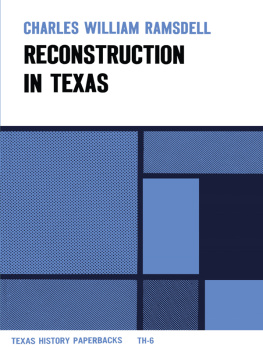William C. Foster - Historic Native Peoples of Texas
Here you can read online William C. Foster - Historic Native Peoples of Texas full text of the book (entire story) in english for free. Download pdf and epub, get meaning, cover and reviews about this ebook. year: 2008, publisher: University of Texas Press, genre: Politics. Description of the work, (preface) as well as reviews are available. Best literature library LitArk.com created for fans of good reading and offers a wide selection of genres:
Romance novel
Science fiction
Adventure
Detective
Science
History
Home and family
Prose
Art
Politics
Computer
Non-fiction
Religion
Business
Children
Humor
Choose a favorite category and find really read worthwhile books. Enjoy immersion in the world of imagination, feel the emotions of the characters or learn something new for yourself, make an fascinating discovery.

- Book:Historic Native Peoples of Texas
- Author:
- Publisher:University of Texas Press
- Genre:
- Year:2008
- Rating:5 / 5
- Favourites:Add to favourites
- Your mark:
- 100
- 1
- 2
- 3
- 4
- 5
Historic Native Peoples of Texas: summary, description and annotation
We offer to read an annotation, description, summary or preface (depends on what the author of the book "Historic Native Peoples of Texas" wrote himself). If you haven't found the necessary information about the book — write in the comments, we will try to find it.
The most complete, up-to-date portrait of Texass Native peoples since W. W. Newcombs 1961 book The Indians of Texas.
Historic Native Peoples of Texas — read online for free the complete book (whole text) full work
Below is the text of the book, divided by pages. System saving the place of the last page read, allows you to conveniently read the book "Historic Native Peoples of Texas" online for free, without having to search again every time where you left off. Put a bookmark, and you can go to the page where you finished reading at any time.
Font size:
Interval:
Bookmark:
HISTORIC NATIVE PEOPLES OF TEXAS
BY WILLIAM C. FOSTER
Foreword by Alston V. Thoms

Copyright 2008 by William C. Foster
All rights reserved
Printed in the United States of America
First edition, 2008
Requests for permission to reproduce material from this work should be sent to:
Permissions
University of Texas Press
P.O. Box 7819
Austin, TX 78713-7819
www.utexas.edu/utpress/about/bpermission.html
 The paper used in this book meets the minimum requirements of ANSI/NISO Z39.48-1992 (R1997) (Permanence of Paper).
The paper used in this book meets the minimum requirements of ANSI/NISO Z39.48-1992 (R1997) (Permanence of Paper).
eISBN: 978-0-2927-8191-7
LIBRARY OF CONGRESS CATALOGING-IN-PUBLICATION DATA
Foster, William C., 1928
Historic native peoples of Texas / by William C. Fosterx; foreword by Alston V.
Thoms. 1st ed.
p. cm.
Includes bibliographical references and index.
ISBN 978-0-292-71792-3 (cl.: alk. paper) ISBN 978-0-292-71793-0 (pbk.: alk. paper)
1. Indians of North AmericaTexasHistorySources. 2. TexasHistory
Sources. I. Title.
E78.T4F67 2008
976.40497dc22
2007043191
TO THOMAS N. CAMPBELL
Alston V. Thoms
Texas, by virtue of its size and geographical setting, is an exceptionally informative place from which to examine Native American lifeways and history on a continental scale. It lies at the intersection of topographically complex and expansive forest, grassland, and desert habitats that encompass much of the continent. To understand and contemplate salient characteristics of Texas ecological and cultural complexity, at any time during the last 15,000 years, is to simultaneously acquire significant knowledge about North Americas southern tier. Said differently, Texas is a microcosm of native Americas hunting, fishing, gathering, farming, and networking lifeways. That microcosmic trend continues into the present, albeit with more people in an evermore technologically complex world.
In Historic Native Peoples of Texas, William C. Foster provides us with an unprecedented opportunity to learn in considerable detail about Indian lifeways during the initial rounds of European exploration in south-central North America. This ethnohistoric saga is based on observations made by more than forty chroniclers who accompanied twenty-five major Spanish expeditions throughout the state and several French forays along the coast and into the northeastern part of the state. The accounts begin with Cabeza de Vacas narrative of the failed Narvez expedition on Galveston Island in 1528 and end in 1722 with the establishment, in the Pineywoods, of the first capital of the Spanish Colonial province of Texas.
For archaeologists, anthropologists, historians, students, and other interested readers, this book provides historical snapshots of Texas ever-changing indigenous landscape and its diversity of hunter-gatherer and horticultural lifeways prior to European military dominance and sustained colonization. Regardless of their shortcomings, these perspectives provide our most historically accurate views of the Native peoples of Texas. It is nonetheless important to recognize that climatic changes were well underway and Texas cultural landscape was in a state of flux during the late 1400s and early 1500s, decades before the arrival of Spanish explorers.
Foster is an eminently respected historian who brings together in the present book a substantial body of information about Texas Indian people that was otherwise embedded in his previous, well-researched books about seventeenth- and eighteenth-century Texas. To that already impressive body of data he added ethnohistoric information derived from all the known sixteenth-century explorers accounts. Historic Native Peoples of Texas includes discussions of well over two hundred Indian groups whose homelands were within eight designated culture areas. Fosters culture areas are derived from the perspectives of the chroniclers of the times. They are delimited primarily by the distribution of culturally related groups who tended to be at peace with one another and frequently formed alliances against groups in adjacent culture areas. These areas do not coincide with ethnographically defined culture areas in southern North AmericaPlains, Southeast, and Southwestthat extend into Texas, although they may be seen as sub-areas thereof. Given Fosters decidedly ethnohistoric perspective, it is not surprising that his culture areas bear little resemblance to the states archaeological regions, which tend to approximate ecological zones.
During the early historic era, Texas was more densely populated by surprisingly diverse groups in comparison to the tribes of the nineteenth century, including the Apache, Caddo, Comanche, Karankawa, Tonkawa, and Wichita. As a testament to the states ever changing cultural landscape it is worth pointing out that, of this list of resident tribes in the nineteenth century, only the Caddo and Karankawa had truly ancient roots in Texas. Apaches arrived sometime in the fifteenth century, not long before the Spaniards, and the Wichita, Tonkawa, and Comanche arrived more than a century later. As one who teaches undergraduate and graduate courses at Texas a&m University in Native American and Texas Indian cultures, I am well aware of the broad patterns and many intricacies of native lifeways. From my decidedly ecological perspectiveand as an archeologist with almost forty years of fieldwork and ethnohistorical research in the stateit is readily apparent that Texas epitomizes the concepts of Native American cultural diversity, continuity, change, and survival through the millennia. Nonetheless, in reading earlier drafts of Historic Natives Peoples of Texas I encountered new ethnohistoric information that is certainly pertinent to my own archaeological and anthropological research.
What contributed substantially to Texas multicultural character were interregional and intra-continental travel corridors that traversed the state for millennia. Native guides led virtually all of the European expeditions into Texas along these routes. Major east-west travel corridors connected Caddo and other communities of mound-building farmers in eastern North America with farmers in New Mexico and other parts of the American Southwest who lived in permanent fortified towns. A major trailway system along Texas Coastal Plain, known archaeologically as the Gilmore Corridor and historically as the Caminos Reales, linked state-level groups in central Mexico with chiefdoms in the Mississippi River basin and beyond. It was probably along these pathways, more than 2,000 years ago, that corn, and later beans, from Mexico were introduced to sedentary hunter-gatherers in the American Southeast.
Foster employs the word cosmopolitan in reference to the well-traveled and geographically knowledgeable Texas Indians. He also uses that term in conjunction with inter-band, multilingual encampments and trade fairs held throughout the state. In doing so, he calls attention to the humanity and ingenuity of these people, as he does elsewhere in this book. For example, he notes that prominent ethnolinguists argue that American Indian sign language may have originated somewhere on the Texas Coastal Plain. He presses the point of indigenous humanity by placing religious practices of Texas Indians into a global context. And he routinely calls upon archaeological data to demonstrate the millennia-old roots of the cosmopolitan nature and humanity of Texas Indians.
Next pageFont size:
Interval:
Bookmark:
Similar books «Historic Native Peoples of Texas»
Look at similar books to Historic Native Peoples of Texas. We have selected literature similar in name and meaning in the hope of providing readers with more options to find new, interesting, not yet read works.
Discussion, reviews of the book Historic Native Peoples of Texas and just readers' own opinions. Leave your comments, write what you think about the work, its meaning or the main characters. Specify what exactly you liked and what you didn't like, and why you think so.




